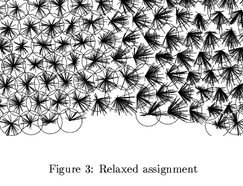neal young / Lupton98Data
-
Journal of Algorithms 27(2):339-356(1998); SODA'96
 The goal of the
Sloan Digital Sky Survey is ``to map in detail
one-quarter of the entire sky, determining the positions and
absolute brightnesses of more than 100 million celestial
objects''. The
survey will be performed by
taking ``snapshots'' through a large telescope.
Each snapshot can capture up to 600 objects
from a small circle of the sky (as illustrated here). This
paper describes the design and implementation of the algorithm
that is being used to determine the snapshots so as to
minimize their number. The problem is NP-hard in general; the
algorithm described is a heuristic, based on
Lagrangian-relaxation and min-cost network flow. It gets
within 5-15% of a naive lower bound, whereas using a
``uniform'' cover only gets within 25-35%.Journal version of [1996].
The goal of the
Sloan Digital Sky Survey is ``to map in detail
one-quarter of the entire sky, determining the positions and
absolute brightnesses of more than 100 million celestial
objects''. The
survey will be performed by
taking ``snapshots'' through a large telescope.
Each snapshot can capture up to 600 objects
from a small circle of the sky (as illustrated here). This
paper describes the design and implementation of the algorithm
that is being used to determine the snapshots so as to
minimize their number. The problem is NP-hard in general; the
algorithm described is a heuristic, based on
Lagrangian-relaxation and min-cost network flow. It gets
within 5-15% of a naive lower bound, whereas using a
``uniform'' cover only gets within 25-35%.Journal version of [1996].
© Copyrights are reserved by the publishers.
Download for personal and limited academic use only.